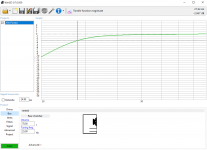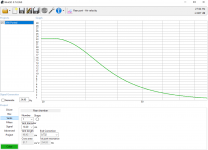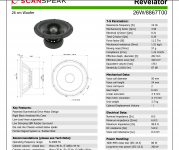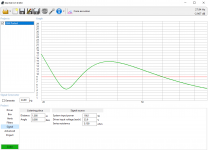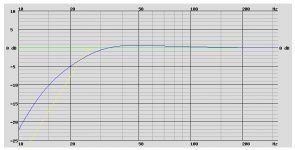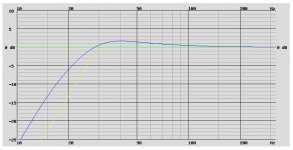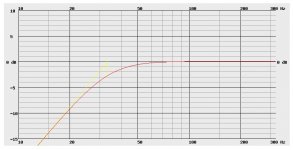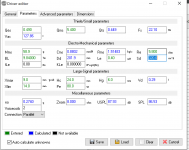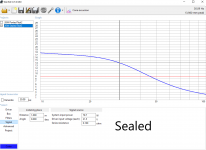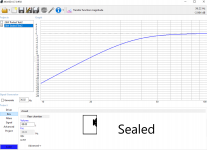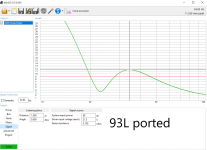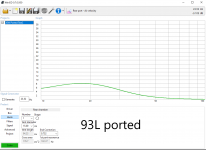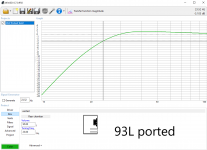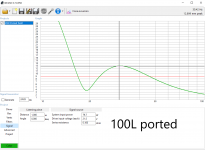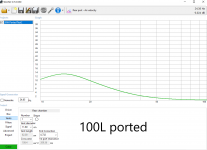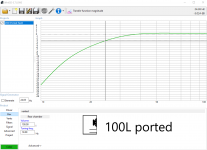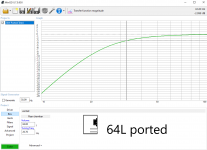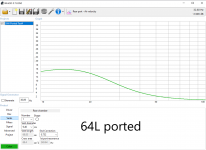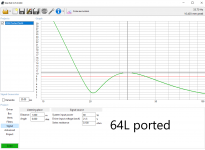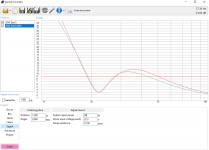Hi,
I am designing my first sub. I was thinking of making it a cube in shape but elongated box would be ok too. I am using WinISD for the design work.
The woofer is Scan-Speak 26W/8867T00. It is rated for 80W RMS and 200W max. Linear excursion is 9mm and max mechanical excursion is 14mm. On its datasheet the recommendations are V=70litres, fb=25Hz, f(-3dB)=28Hz. I put the recommended volume and tuning frequency into WinISD and changed input power to see what I would get from the plots.
The transfer function magnitude had
0dB at 97.71Hz
-3dB at 27.84
I looked at cone excursion.
At 200W:
*Max mechanical excursion is 14.834mm at 36.91Hz
At 80W:
*Max mechanical excursion is 9.353mm at 36.91Hz
Something doesn't seem right to me. I need to lower the volume to 56litres to not have the driver excursion go over the ratings. Are Scan-Speak recommendations off?
I looked at port velocity.
At 200W:
*23.494m/s at 21.66Hz
At 80W:
*14.812m/s at 21.77Hz
Is that velocity too much? I chose 1 circular port with a diameter of 10.2cm. The vent length is 48.42cm, which is longer than my external cube dimensions. Would there be a problem if the tube has a bend in it? Does the bend angle and arc length make a difference? I had a look at making the port diameter smaller to make the tube length shorter but the velocity jumps up to 36.353m/s at 200W and 22.92m/s at 80W. Is that too high?
The plate amp I was thinking of using is either Hypex FA252 which can do 150W RMS @ 8Ohm or 300W RMS @ 8Ohm. Would it be better to run the plate amp at 150W or 300W? I don't want to blow the woofer, and those excursion numbers look too high even at 80W.
Would someone be able to assist in the design to make sure that I don't damage the woofer?
Thanks
I am designing my first sub. I was thinking of making it a cube in shape but elongated box would be ok too. I am using WinISD for the design work.
The woofer is Scan-Speak 26W/8867T00. It is rated for 80W RMS and 200W max. Linear excursion is 9mm and max mechanical excursion is 14mm. On its datasheet the recommendations are V=70litres, fb=25Hz, f(-3dB)=28Hz. I put the recommended volume and tuning frequency into WinISD and changed input power to see what I would get from the plots.
The transfer function magnitude had
0dB at 97.71Hz
-3dB at 27.84
I looked at cone excursion.
At 200W:
*Max mechanical excursion is 14.834mm at 36.91Hz
At 80W:
*Max mechanical excursion is 9.353mm at 36.91Hz
Something doesn't seem right to me. I need to lower the volume to 56litres to not have the driver excursion go over the ratings. Are Scan-Speak recommendations off?
I looked at port velocity.
At 200W:
*23.494m/s at 21.66Hz
At 80W:
*14.812m/s at 21.77Hz
Is that velocity too much? I chose 1 circular port with a diameter of 10.2cm. The vent length is 48.42cm, which is longer than my external cube dimensions. Would there be a problem if the tube has a bend in it? Does the bend angle and arc length make a difference? I had a look at making the port diameter smaller to make the tube length shorter but the velocity jumps up to 36.353m/s at 200W and 22.92m/s at 80W. Is that too high?
The plate amp I was thinking of using is either Hypex FA252 which can do 150W RMS @ 8Ohm or 300W RMS @ 8Ohm. Would it be better to run the plate amp at 150W or 300W? I don't want to blow the woofer, and those excursion numbers look too high even at 80W.
Would someone be able to assist in the design to make sure that I don't damage the woofer?
Thanks
Attachments
Last edited:
With the 2 different alignments below I would go with the first for a better blending with the room and lower frequency infra-sound (@25-15Hz) and less power restrictions.
Note: use amp @8 Ohms and port air speed <14.3 m/s. Ports can have a bend: Link here
SCAN SPEAK 26W8867T00, VB = 64.0 L, FB = 20.7 Hz
PORT: 1x 9.4 cm x 68.7 cm (D/L), pas: 13.4 m/s
107.3 dB (1 m.) Xmax = 9.0 mm P = 83.4 W, 6.8 Ohms@20.7 Hz
SCAN SPEAK 26W8867T00, VB = 70.0 L, FB = 25.0 Hz
PORT: 1x 11.8 cm x 66.0 cm (D/L), pas: 12.2 m/s
106.4 dB (1 m.) Xmax = 9.0 mm P = 65.6 W, 7.2 Ohms@25.0 Hz
Note: use amp @8 Ohms and port air speed <14.3 m/s. Ports can have a bend: Link here
SCAN SPEAK 26W8867T00, VB = 64.0 L, FB = 20.7 Hz
PORT: 1x 9.4 cm x 68.7 cm (D/L), pas: 13.4 m/s
107.3 dB (1 m.) Xmax = 9.0 mm P = 83.4 W, 6.8 Ohms@20.7 Hz
SCAN SPEAK 26W8867T00, VB = 70.0 L, FB = 25.0 Hz
PORT: 1x 11.8 cm x 66.0 cm (D/L), pas: 12.2 m/s
106.4 dB (1 m.) Xmax = 9.0 mm P = 65.6 W, 7.2 Ohms@25.0 Hz
H!
I don't want to be a troll here but Scan-Speak T/S data is often very inaccurate and doesn't reflect the reality. This is especially true with these larger Revelator drivers. That 26W have a Qts well over 0.4 in real world and not 0.29 as the datasheet states.
Every 3rd party measurement shows that.
SS 26W test data
I don't want to be a troll here but Scan-Speak T/S data is often very inaccurate and doesn't reflect the reality. This is especially true with these larger Revelator drivers. That 26W have a Qts well over 0.4 in real world and not 0.29 as the datasheet states.
Every 3rd party measurement shows that.
SS 26W test data
With the new data for the driver provided by YSDR.
1. Driver good for sealed speaker or quarter wave type.
Sealed: SCAN SPEAK 26W/8867T00 vp, VB = 88.0 L, Fc = 33.5 Hz, Qtc = 0.731
2. In the case of a BR I model a first approach to see the alignment and where to go from here. (driver with the new T/S parameters from post#5)
a. SCAN SPEAK 26W/8867T00 new, VB = 95.0 L, FB = 23.0 Hz
PORT: 1x 15.0 cm x 94.0 cm (D/L), Pas: 9.9 m/s
F-3 dB = 23 Hz, F-6 dB = 20 Hz
105.2 dB (1 m.) Xmax = 9.0 mm P = 70.5 W. 7.1 Ohms@23.0 Hz, V = 22.34 V
note: protect (high pass) for XLim 14mm under 17/20Hz with P.
b. SCAN SPEAK 26W/8867T00 new, VB = 100.0 L, FB = 19.0 Hz
PORT: 1x 11.8 cm x 81.8 cm (D/L), Pas: 11.4 m/s
F-3 dB = 23 Hz, F-6 dB = 19 Hz
105.8 dB (1 m.) Xmax = 9.0 mm P = 83.3 W. 6.9 Ohms@19.0 Hz, V = 23.99 V
high pass: good for <15Hz@14mmXLim (P)
1. Driver good for sealed speaker or quarter wave type.
Sealed: SCAN SPEAK 26W/8867T00 vp, VB = 88.0 L, Fc = 33.5 Hz, Qtc = 0.731
2. In the case of a BR I model a first approach to see the alignment and where to go from here. (driver with the new T/S parameters from post#5)
a. SCAN SPEAK 26W/8867T00 new, VB = 95.0 L, FB = 23.0 Hz
PORT: 1x 15.0 cm x 94.0 cm (D/L), Pas: 9.9 m/s
F-3 dB = 23 Hz, F-6 dB = 20 Hz
105.2 dB (1 m.) Xmax = 9.0 mm P = 70.5 W. 7.1 Ohms@23.0 Hz, V = 22.34 V
note: protect (high pass) for XLim 14mm under 17/20Hz with P.
b. SCAN SPEAK 26W/8867T00 new, VB = 100.0 L, FB = 19.0 Hz
PORT: 1x 11.8 cm x 81.8 cm (D/L), Pas: 11.4 m/s
F-3 dB = 23 Hz, F-6 dB = 19 Hz
105.8 dB (1 m.) Xmax = 9.0 mm P = 83.3 W. 6.9 Ohms@19.0 Hz, V = 23.99 V
high pass: good for <15Hz@14mmXLim (P)
Attachments
I keep getting different results to you for cone excursion.
I used the data from post #5
My results are in the screenshots. Inductor, what are you using for your simulations? Is my WinISD producing bad results? Am I putting in the data wrong?
Thanks for helping
Edit: I am using C4/SC4 (Sub-)Chebyshev alignment option in WinISD, if that makes a difference.
I used the data from post #5
My results are in the screenshots. Inductor, what are you using for your simulations? Is my WinISD producing bad results? Am I putting in the data wrong?
Thanks for helping
Edit: I am using C4/SC4 (Sub-)Chebyshev alignment option in WinISD, if that makes a difference.
Attachments
Last edited:
With the 2 different alignments below I would go with the first for a better blending with the room and lower frequency infra-sound (@25-15Hz) and less power restrictions.
Note: use amp @8 Ohms and port air speed <14.3 m/s. Ports can have a bend: Link here
SCAN SPEAK 26W8867T00, VB = 64.0 L, FB = 20.7 Hz
PORT: 1x 9.4 cm x 68.7 cm (D/L), pas: 13.4 m/s
107.3 dB (1 m.) Xmax = 9.0 mm P = 83.4 W, 6.8 Ohms@20.7 Hz
My results for this show cone excursion being 10.4mm. Screenshots show my results. I wonder if the difference is just the simulation program, but which one is more accurate? I don't want to blow go outside of Xmas.
Attachments
With the new data for the driver provided by YSDR.(...)
Check the NEW measured T/S parameters he provided in his link and use them so you know what to expect. It was after 200 hours of use. Maybe also a good idea measuring your drivers after all.
Last edited:
My 100L and 93L screenshots were with the measurements from post #5.
I read this:
Jensen-1071
That project is a 3 way. It has a sub that is separate to mid and tweeter. The sub driver for that project is 26W/8861T00, which can handle 170W RMS. I ran the simulation with 26W/8871T00 and compared it to my simulations of 26W/8867T00. Both drivers have the same Xmas.
As per that project I simulated 80L ported enclosure with fb=22Hz. But my port length in WinISD seems to be shorter than what the project has. Should I go with WinISD results or with what project had?
I found that the 8861T00 simulation shows cone excursion that is worse than 8867T00! Now, the Jensen 1071 speakers work and I have seen no reports that the sub driver has blown. I've also not seen a report to say that the sub driver is outside of its linear range.
So despite what the simulation shows my 8867T00 should work ok?
Screenshot of cone excursion simulation results between 8867T00 and 8861T00 is attached.
I read this:
Jensen-1071
That project is a 3 way. It has a sub that is separate to mid and tweeter. The sub driver for that project is 26W/8861T00, which can handle 170W RMS. I ran the simulation with 26W/8871T00 and compared it to my simulations of 26W/8867T00. Both drivers have the same Xmas.
As per that project I simulated 80L ported enclosure with fb=22Hz. But my port length in WinISD seems to be shorter than what the project has. Should I go with WinISD results or with what project had?
I found that the 8861T00 simulation shows cone excursion that is worse than 8867T00! Now, the Jensen 1071 speakers work and I have seen no reports that the sub driver has blown. I've also not seen a report to say that the sub driver is outside of its linear range.
So despite what the simulation shows my 8867T00 should work ok?
Screenshot of cone excursion simulation results between 8867T00 and 8861T00 is attached.
Attachments
Last edited:
Don't forget that xmax is just a mathematical relation of the pole plate height and voice coil length. Non-linearities are always present, which can be bad within xmax and can be not-so bad above xmax too, depending on many things like suspension or inductance linearity etc. Although the SS Revelators are very linear devices amongst hifi drivers.
- Status
- This old topic is closed. If you want to reopen this topic, contact a moderator using the "Report Post" button.
- Home
- Loudspeakers
- Subwoofers
- Requesting assistance with Scan-Speak 26W/8867T00 subwoofer design
